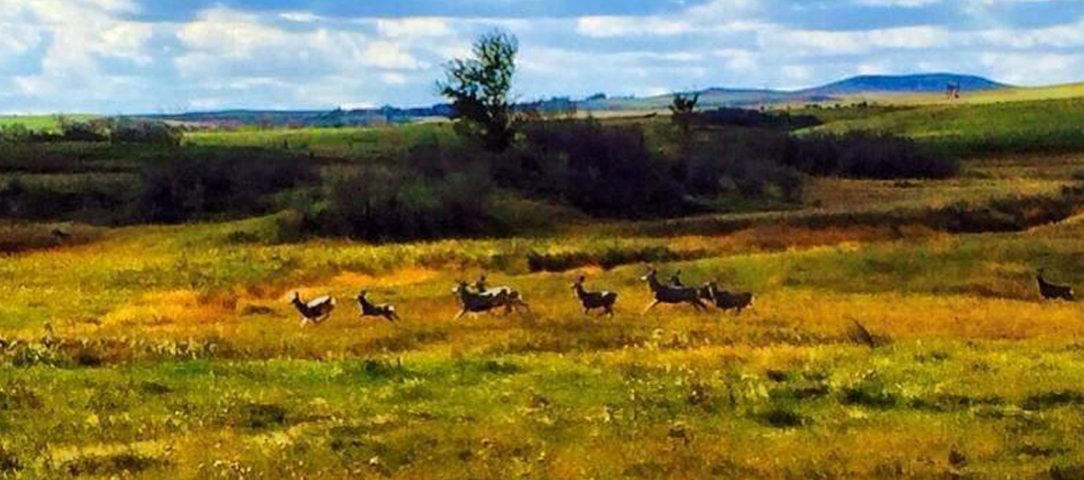General Alfred Sully’s troops fought the Sioux here back in 1864, seeking revenge for the Minnesota Massacre of two years earlier. Only two of Sully’s 3,000 soldiers were killed, compared to an estimated 100 Indian warriors. To get there, you take the first left off the Highway 22, north of the airport, and Markers will guide you to the battlefield.
The Battle of the Killdeer Mountains may have involved more soldiers and warriors than any other single encounter between the United States and Indian nations west of the Mississippi River, including Custer’s Last Stand at Little Big Horn. As many as 4000 combatants may have been involved in the encounter. Sitting Bull was there, along with other Lakota and Dakota Sioux warriors from all over the region. General Alfred Sully was there along with his companies.
In the 1850’s, The U.S. Government made treaties with the Indians in Minnesota. These treaties gave them land, money, food, clothing and farming utensils. The Indian Agents in charge were negligent in issuing these commodities. As a result, the Minnesota Massacres of 1862 occurred.
The Sioux warriors fled into Dakota Territory. General Sully was sent to punish them. In 1863, he found a large Sioux village at Whitestone Hill. This battle was the bloodiest confrontation ever held on Dakota soil. Whitestone Hill apparently not being enough punishment in the eyes of the Minnesotans, Sully returned to Dakota Territory in 1864. On July 27th, Sully’s men marched an incredible 47 miles to get within striking distance of the Sioux village. It was a big village. It is estimated that there were between 900- 1600 lodges with 3000 to 5000 warriors in them.
In order to give Sully the fight that they knew he wanted, the Sioux began to consolidate their village on the Knife River. As scouting parties brought word of Sully’s approach, the chiefs moved the big village a day’s journey north to the edge of a low range of rugged, wooded mountains that fell away on the north to the tumbled badlands of the Little Missouri River. A series of buttes and ridges, separated by steep ravines and gorges choked with brush and stunted timber, rose stairlike to the dominating mountain mass. In the natural fortress formed by these foothills, near a pleasant spring, which puts out 40 gallons of fresh clear water per minute, the Indians put their camp, fully four miles in length. This area was a favorite hunting ground
and the Lakota’s called it Takahokuty – “the place where they killed the deer: or in white man’s language, the Killdeer Mountains. The village stirred with excitement as warriors painted and dressed for the battle. Confident in their numbers, they did not order the lodges packed and the village moved. The women, children and old men gathered on a high hill to watch.
Sully had judged the terrain too broken for mounted action and had dismounted to advance on a broad front of skirmishers. Resplendent in paint and war costume, the warriors sat their ponies in little clusters on every hill and ridge facing the blue lines and curling around the flanks.
The Hunkpapa Lone Dog opened the fray. He would go close to the soldiers, he said and if they shot at him the Indians would all open fire. Soon three bullets zipped around him, and he quickly rode behind the hill.
For five miles the fighting rolled northward toward the village at the foot of the Killdeer Mountains. The Indians fought in typical fashion, warriors singly and in knots galloping to and fro, stabbing suddenly toward the soldiers to loose arrows or musket balls, withdrawing quickly, sometimes gathering in large groups for a daring thrust aimed at piercing the enemy lines.
Despite their unusual strength, the Sioux could not slow the steady advance of the soldiers. The Indians had never before seen white soldiers fight. The number of guns surprised them and the amount of shooting was more than the Indians had expected. The cannon, which shot so loud and so far and so often, was a big surprise to them. Bows and arrows and trade muskets proved no match for long-range rifles and the cannon, which swung into action whenever a warrior force grew too bold.
The warriors stood firm, resisting desperately in hand-to-hand combat and releasing arrows from the cover of the brush. For a mile and a half they conducted a stubborn steep butte. There the fray intensified, but the soldiers dismounted and directed a heavy carbine fire at the defenders, who finally broke and scattered. In the action, the Indians lost 27 and the soldiers two.
The soldiers won final victory, scattering men, women and children into the mountains and seizing the village. The women had taken down a few lodges, but most remained intact. They had also thrown meat into the ravines, hoping to return and retrieve it. But the soldiers methodically destroyed everything that could benefit the Indians. Lodges, meat, robes, and utensils, all went up in flames the next day. The soldiers burned over two hundred tons of supplies and equipment. Before the soldiers departed Col. Robert McLarsen, ordered the nearby woods in all directions to be burned.
For Indians who had taunted the Great Father to send real soldiers, not women dressed as soldiers, Killdeer Mountains was a stunning defeat. The Sioux had fought bravely, but the soldiers’ rifles, cannon and six-shooters overwhelmed their feeble weapons. The loss of the village and all its contents was a grievous blow.
On the night of July 28, the Sioux had thwarted further pursuit by scattering through the western foothills of the Killdeer Mountains and losing themselves in the tangled terrain of the Little Missouri Badlands, where the cavalry could not catch them.
Information obtained from the books “The Lance and The Shield’ The Life and Times of Sitting Bull” by Robert m Utley and from “Brackett’s Battalion, Minnesota Cavalry” by Kurt D Bergemann.

